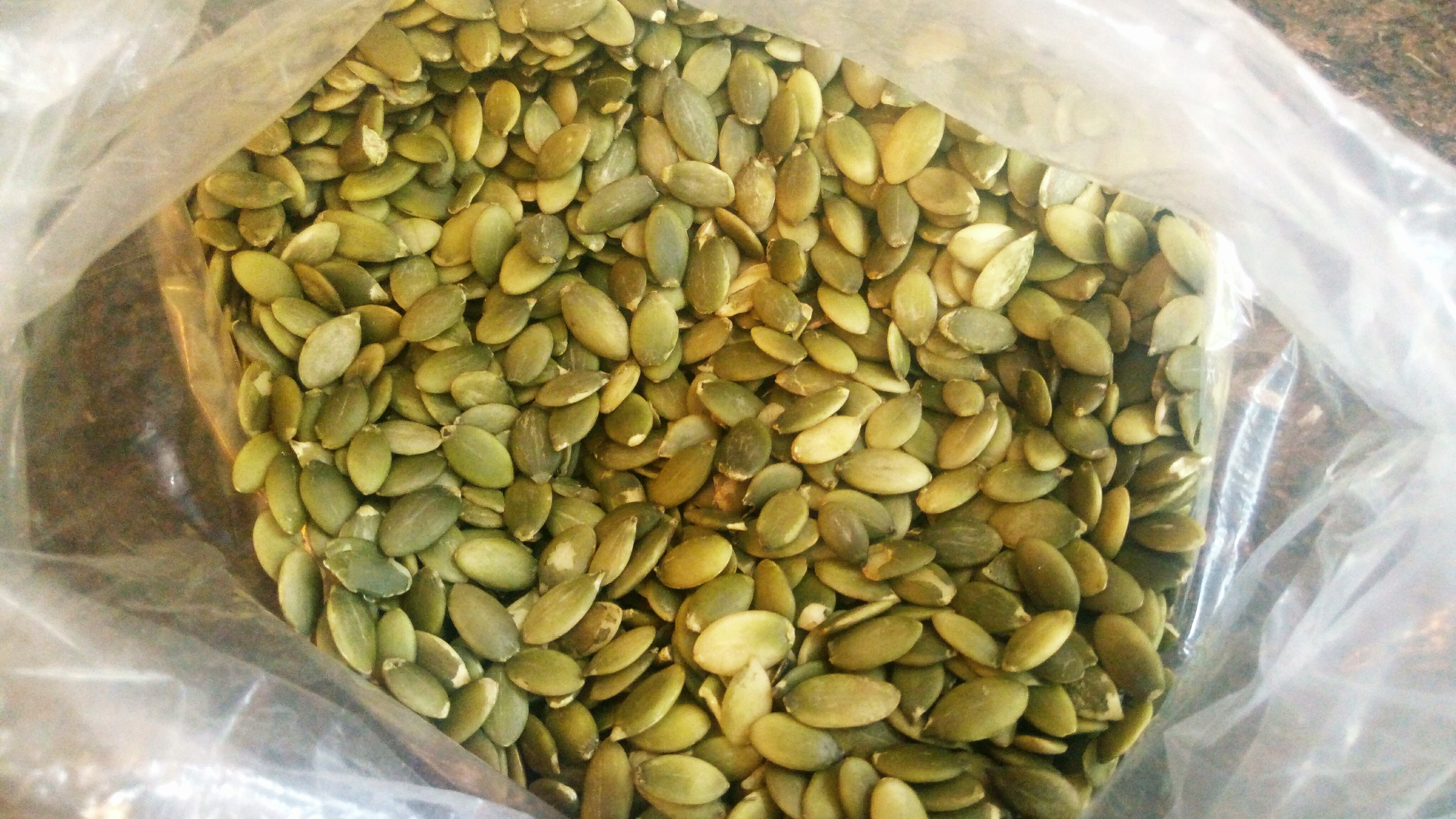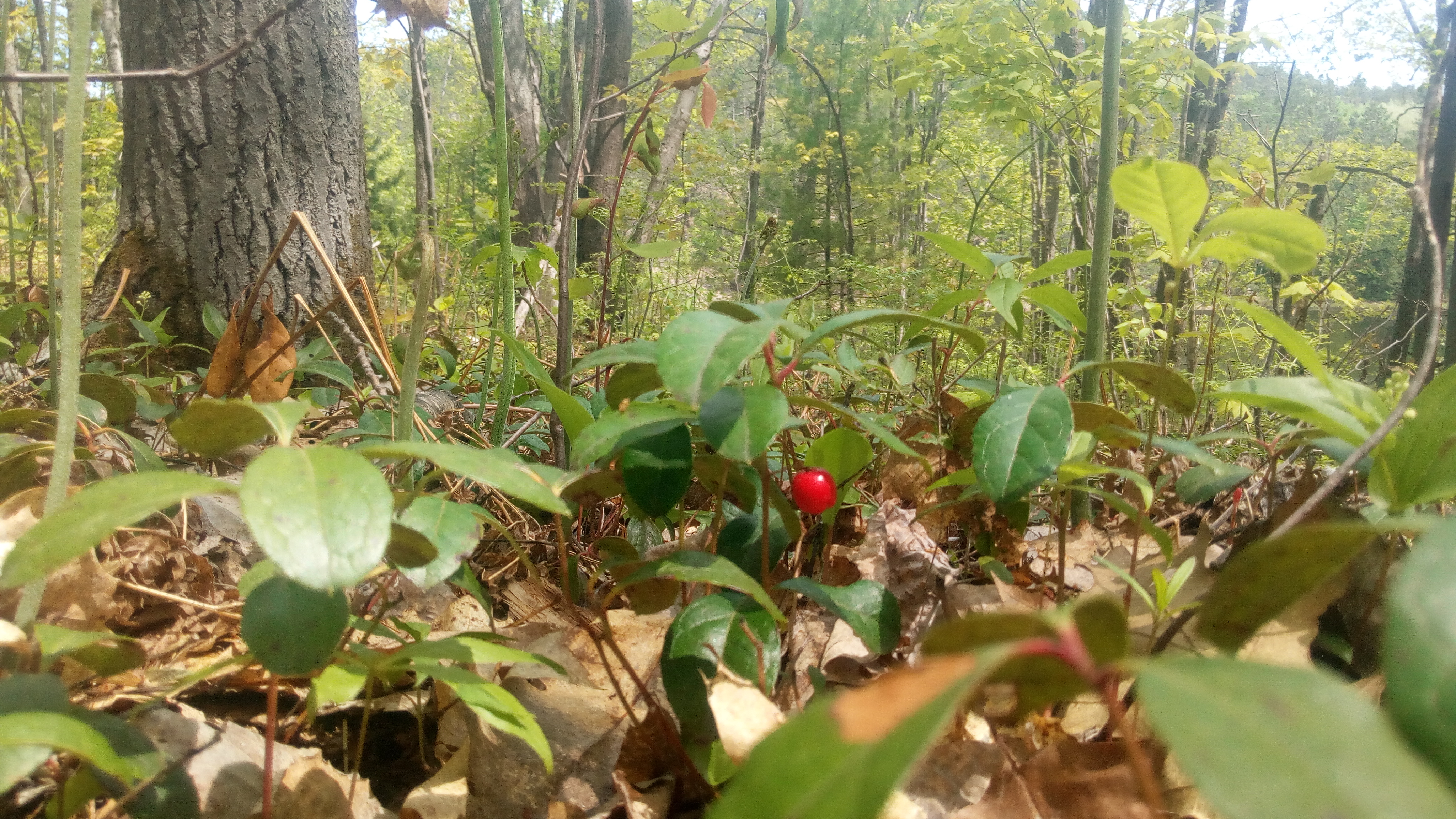
Pumpkin seed kernels are a good source of protein, essential fats, fiber, magnesium and other vitamins and minerals – and a great source of zinc which may be lacking in vegetarian or vegan diets. (Pumpkin Seeds – Benefits, nutrition and dietary tips.) (Other vegetarian sources of zinc.)
Work is progressing on the development of pumpkin seed flour for use as a food thickening substance for use in gravies or other sauces or stews. It would increase the protein, essential fatty acids, and other trace nutrient content of the resulting foods. (10) The use of pumpkin seeds in the diet may also prove to be protective against cancer and liver or kidney injury; and as a good source of antioxidants such as carotenoids (vitamin A family of nutrients) the use of pumpkin seeds in the diet may prove to be helpful against many conditions that involve excess oxidative stress. (4, 5, 6, 7, 8, 9) They are also a source of vitamin E (tocopherols), other phytosterols, and linoleic acid, a beneficial polyunsaturated fat. Pumpkin seed oil may be helpful in wound healing. (15) Pumpkin seeds are also a good source of phospholipids, (16), which are important for skin and membrane health.
Pumpkins are considered a drought tolerant plant for gardeners. Adequate water is needed to grow larger pumpkin and squash but the vines can survive limited water conditions. The seeds of other summer and winter squash are also nutrient rich and also may be more drought tolerant plants. (11, 12) Enough but not too much water at the right times are critical. Flooding or severe drought may both harm the garden yield. Mulching and drip irrigation or other watering methods applied at optimal stages of growth can be the water thrifty solution for best yield. (13, 14)
The seeds of butternut squash and some types of winter squash can be collected when trimming the squash and later toasted and eaten as a crunchy nutritious snack. India grocery markets may also have shelled squash seeds available for sale. They are slightly smaller and paler in color than the shelled pumpkin kernels in the image above.
Magnesium is one of the beneficial nutrients found in pumpkin seeds. It is a mineral that is needed in greater quantity during pregnancy and high blood pressure/hypertension can be a symptom of deficiency. Preeclampsia and the more severe eclampsia are complications characterized by high blood pressure and edema/swelling that can occur during pregnancy. Toxins collect in the excess fluid buildup and can risk a brain condition similar to hypertension encephalopathy in the more severe eclampsia. Seizure activity can result and death for the woman and expected infant are risks. Magnesium is used as an intravenous or intramuscular injection to reduce risk of the seizures during eclampsia. The mineral seems to help protect the blood brain barrier and reduce swelling in the brain during eclampsia. It’s role as an antioxidant to reduce free radical toxins may be involved but the exact mechanism for its benefit in eclampsia is not known. (2, page 139)
More information about preclampsia is available in a previous post, and more information about food sources and supplement sources of magnesium is also available in a previous post.
I have several writing projects in draft mode however they overlap – pumpkin seeds, a good source of magnesium and zinc, helped my previous prenatal clients who had a history of preeclampsia or high blood pressure in a previous pregnancy prevent a reocurrence of the problem. Why? Possibly because of the magnesium and other beneficial nutrients which could be protecting the blood brain barrier and might then also be helpful for preventing harm to oligodendrocytes and protect against demyelination – a risk that can occur with some types of encephalopathy (3).
Disclaimer: Opinions are my own and the information is provided for educational purposes within the guidelines of fair use. While I am a Registered Dietitian this information is not intended to provide individual health guidance. Please see a health professional for individual health care purposes.
- https://www.ncbi.nlm.nih.gov/pmc/articles/PMC4827242/Megan Ware, What are the health benefits of pumpkin seeds?, July 24, 2018, https://www.medicalnewstoday.com/articles/303864.php
- Mehmet Kaya, Bulent Ahishali, Chapter 9: The role of magnesium in edema and blood brain barrier disruption, page 139, in the book edited by Robert Vink, Mihai Nechifor, Magnesium in the Central Nervous System, University of Adelaide Press, 2011, adelaide.edu.au, free ebook pdf, https://www.adelaide.edu.au/press/titles/magnesium/magnesium-ebook.pdf (2)
- S. Love, Demyelinating Diseases, J Clin Pathol. 2006 Nov; 59(11): 1151–1159. https://www.ncbi.nlm.nih.gov/pmc/articles/PMC1860500/ (3)
- Scientific Studies collection on a commercial website by Pepo Farms, https://pepofarms.com.au/scientificstudies/ (4) which includes:
- M. Gossell-Williams, A. Davis, N. O’Connor, Inhibition of Testosterone-Induced Hyperplasia of the Prostate of Sprague-Dawley Rats by Pumpkin Seed Oil. Jun 2006, Vol. 9, No. 2 : 284 -286.
- C. Z. Nkosi, A. R. Opoku, S. E. Terblanche, Antioxidative effects of pumpkin seed (Cucurbita pepo) protein isolate in CCl4-Induced liver injury in low-protein fed rats.
- Fahim AT Abd-el Fattah AA Agha AM Gad MZ
Effect of pumpkin-seed oil on the level of free radical scavengers induced during adjuvant-arthritis in rats.
In: Pharmacol Res (1995 Jan) 31(1):73-9 ISSN: 1043-6618 - Suphakarn VS Yarnnon C Ngunboonsri P, The effect of pumpkin seeds on oxalcrystalluria and urinary compositions of children in hyperendemic area. In: Am J Clin Nutr (1987 Jan) 45(1):115-21 ISSN: 0002-9165
- Matus Z Molnar P Szabo LG [Main carotenoids in pressed seeds (Cucurbitae semen) of oil pumpkin (Cucurbita pepo convar. pepo var. styriaca)] Olajtok (Cucurbita pepo convar. pepo var. styriaca) magjabol nyert presmaradek ossz-karotinoid-tartalmanak es karotinoid-osszetetelenek meghatarozasa. In: Acta Pharm Hung (1993 Sep) 63(5):247-56 ISSN: 0001-6659 (Published in Hungarian) * The main carotenoids included per the Pepo Farms site: “The main components of the press-residue were lutein [3,3′-dihydroxy-alpha-carotene = (3R,3’R,6’R)-beta,epsilon-carotene-3,3′-diol; 52.5%] and beta- carotene (beta,epsilon-carotene; 10.1%). In addition to the above- mentioned pigments it was successful to reveal the presence of violaxanthin, luteoxanthin, auroxanthin epimers, lutein epoxide, flavoxanthin, chrysanthemaxanthin, 9(9′)-cis-lutein, 13(13′)-cis- lutein, 15-cis-lutein (central-cis)-lutein, alpha-cryptoxanthin, beta- cryptoxanthin and alpha-carotene (beta,epsilon-carotene) in small quantities.” (4)
- Initial food technology research on the preparation and use of pumpkin seed flour for use in more nutritious gravy type sauces: Sharma G, Lakhawat S., Development, Quality Evaluation and Acceptability of Pumpkin Seed Flour Incorporated in Gravy. J Nutr Food Sci 7:613. doi: 10.4172/2155-9600.1000613 https://www.omicsonline.org/open-access/development-quality-evaluation-and-acceptability-of-pumpkin-seed-flourincorporated-in-gravy-2155-9600-1000613.php?aid=91345
- EllenB, Growing Drought Tolerant Vegetables, June 9, 2009, ThriftyFun.com, https://www.thriftyfun.com/Growing-Drought-Tolerant-Vegetables.html (11)
- Troy Scott, Drought Tolerant Vegetables for your Garden, July 9 2018, HeavenlyGreens.com http://www.heavenlygreens.com/blog/drought-tolerant-vegetables-for-your-garden (12)
- Joan Morris, Vegetable Gardening in a Drought, mercurynews.com, April 1, 2015, https://www.mercurynews.com/2015/04/01/vegetable-gardening-in-a-drought/ (13)
- Extension Utah State University, Vegetable Irrigation: Squash and Pumpkin, Horticulture/Vegetables/2015-4, https://digitalcommons.usu.edu/cgi/viewcontent.cgi?article=1744&context=extension_curall (14)
- Bardaa S, Ben Halima N, Aloui F, et al. Oil from pumpkin (Cucurbita pepo L.) seeds: evaluation of its functional properties on wound healing in rats. Lipids in Health and Disease. 2016;15:73. doi:10.1186/s12944-016-0237-0. https://www.ncbi.nlm.nih.gov/pmc/articles/PMC4827242/ (15)
- Zh.Y. Petkova, G.A. Antova, Changes in the composition of pumpkin seeds (Cucurbita moschata) during development and maturation. Grassas Y Aceites, 66 (1), Jan–March 2015, e058. http://grasasyaceites.revistas.csic.es/index.php/grasasyaceites/article/viewFile/1523/1658 (16)

